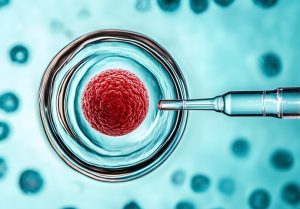Although some studies suggest that artificial insemination may have adverse effects on future offspring, there is also research showing that conception through assisted reproductive technology (ART) such as IVF can have positive effects and bring some benefits to quality of life in adulthood. The results of a study published in Human Fertility offer reassuring news for people who were conceived using ART—and for those who still need this technology.
The Impact of IVF on Quality of Life in Adulthood
“Our findings suggest that conception through ART may confer some benefits for quality of life in adulthood, independent of other psychosocial factors,” said lead author Karin Hammarberg of Monash University in Melbourne, Australia. “Together with previous findings that adults conceived through ART have similar physical health to people conceived naturally, this is reassuring for people conceived through ART – and for those who need ART to conceive.”
In the more than four decades since the first birth following in vitro fertilization (IVF) in 1978, more than 8 million children have been born thanks to assisted reproductive technologies (ART). During this time, numerous studies have examined the physical health, development, and psychosocial well-being of ART-conceived children compared to naturally conceived children (NC). However, less is currently known about the health and quality of life of adults conceived through ART.
This study involved 193 young adults conceived through artificial insemination and 86 NC-conceived young adults from the Australian state of Victoria. These participants completed questionnaires that included a standardized measure of quality of life (World Health Organization Quality of Life – Brief Assessment (WHOQoL-BREF)) at ages 18 to 28 (T1) and again at ages 22 to 35 (T2). The WHOQoL-BREF assesses four areas of quality of life: 1) physical health, 2) psychosocial health, 3) social relationships, and 4) environment. The researchers examined the associations between the factors present at T1 (type of conception, age of mother at birth of participant, sexual orientation, family financial situation during secondary school, perception of own weight, number of close friends, frequency of intense physical activity, and quality of relationship with parents) and the scores in the four domains of the WHOQoL-BREF at T2.
Long-Term Effects of Assisted Reproductive Technologies on Physical Health and Well-Being
After statistical adjustment for other psychosocial factors that play a role in young adulthood, the results showed that conception through assisted reproduction was highly associated with higher scores (better quality of life) in the WHOQoL-BREF domains “social relationships” and “environment” at T2. In addition, lower psychological distress, a more positive relationship with parents, a better financial situation, and the perception of being at the right weight at T1 were associated with higher scores in one or more WHOQoL-BREF domains at T2.
Children conceived through assisted reproductive technologies now make up a significant proportion of the population, and it is important to continue to investigate the long-term effects of these technologies on their physical health and well-being during the transition from adolescence to adulthood,” said Hammarberg. Taking into account other factors that play a role in young adulthood, conception through ART appears to confer certain benefits for quality of life.
Perhaps unsurprisingly, the researchers also found that regardless of how the person was conceived, a better relationship with parents, less psychological distress, and a better family financial situation in young adulthood contributed to better quality of life in adulthood. This is the first study to examine the influence of conception through ART and psychosocial factors in young adulthood on the quality of life of adults. While the results are reassuring, they should be interpreted with caution, as many of the participants in the initial study did not participate in the follow-up study. Further studies examining the long-term health effects of children conceived through ART are therefore important.






